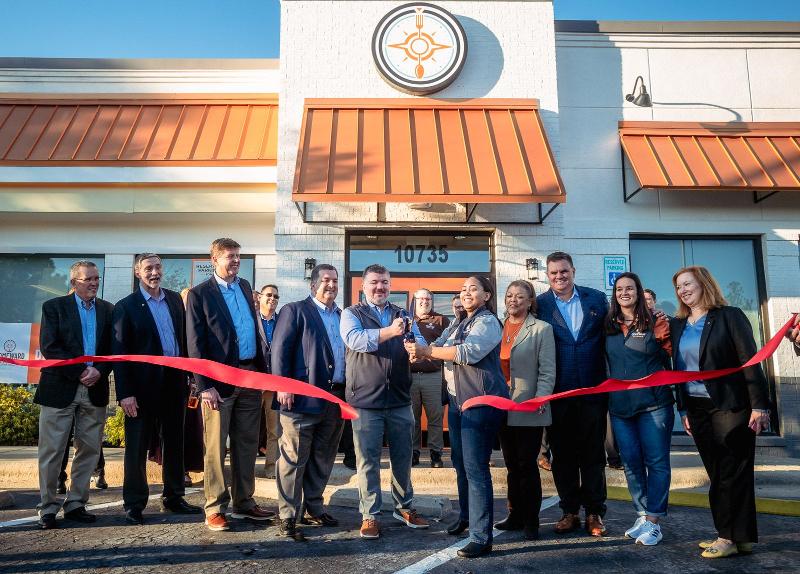
While the world was going ga-ga last week over McDonald’s first-ever CosMc’s, another industry giant was firing up the ovens of its second concept. Or, as Golden Corral might have declared in raising the curtain on the venture, a fast-casual start-up called Homeward Kitchen, the learnings were about to begin.
The initial outpost is intended to be a prototype, not a lab experiment. It’s already performing at a level that suggests management was conservative in projecting first-year sales of $3 million, and about 20 Golden Corral franchisees have already asked if they can develop one.
Industry veteran Kerry Kramp, who helped with the launch, also wants to be part of the rollout. For 12 years, he headed Golden Corral’s major competitor, Buffets Inc.
Yet, as Golden Corral CEO Lance Trenary readily acknowledges, the 51-year-old mother brand is in unfamiliar territory. The pot roast sold by Homeward Kitchen may be identical to the version showcased at a Golden Corral, but the fast-casual market is alien turf to a team that had never veered away from buffets.
“Right now we’re on a learning curve,” Trenary said during an interview via Zoom. Staffing Homeward Kitchen, “We wanted to hire people who had QSR or fast-casual experience, because we didn’t.”
The Golden Corral team has deep experience in restaurant operations, however, an indisputable strength of a brand that features hundreds of made-from-scratch items across three dayparts. Controlling food waste is typically a huge challenge for a buffet. Golden Corral has devoted five decades to mastering the task.
That aptitude was applied to the three-year ramp-up to Homeward Kitchen’s debut, says Trenary. He notes that the venture will be overseen by an operations specialist, JasonKornosky, whose title as brand leader is VP of operations.
The first Saturday after Homeward Kitchen’s official opening was spent polishing operations, according to Trenary. The team focused on such details as serving vessels, portion sizes and the packaging used for onsite orders. The concept was designed for a high volume of to-go orders, with a drive-thru window, a mobile menu accessible via QR code, delivery service and a walk-up counter. “We’re already doing ten-fold the off-premise business of a Golden Corral,” said Trenary.
Only a small dining area is provided for dine-in guests.
Portion sizes are important because Homeward Kitchen wants to impress patrons with the value it provides, says Trenary. For a ticket averaging $15 per person, guests get a hefty serving, though the exact size is still under discussion, he adds.
By design, the customers are somewhat different from the clientele of a Golden Corral, Trenary notes. “That was part of the strategy, to attract a slightly younger, more on-the-go customer,” he explains. A Golden Corral visit, in contrast, tends to be a sit-down occasion, with guests skewing older in age.
A big difference between Homeward Kitchen and a Golden Corral is the level of technology. Every advance used in the buffet restaurants has been incorporated into the new venture, but the fast-casual goes much farther, given its emphasis on delivery and to-go sales. At least some of the innovations may be retrofitted into the buffets, according to Trenary.
Although the company doesn’t hide the connection between Homeward Kitchen and Golden Corral, it doesn’t trumpet it to customers, either. The company considered naming the new venture “Homeward Kitchen by Golden Corral,” but research sank the idea. “If it had ‘Golden Corral’ in the name, people expected a buffet,” explains Trenary, “They couldn’t get past it.”
The difference between the two brands will be readily evident to developers. A typical Golden Corral measures 10,000 to 12,000 square feet and requires about three acres of land. “The investment is probably in the $5 million to $6 million range,” says Trenary.
For Homeward Kitchen, “we believe the total for building and equipment will be under $2 million,” he continues. “We need just slightly over an acre.”
The company does not plan to stop developing Golden Corrals, Trenary stresses. The pandemic was brutal for the buffet brand, but “the comeback has been greater than the setback,” says Trenary. Same-store sales this year are running 15% above the 2022 level, and order counts are outstripping last year’s tally by 8%.
“Our average unit volume in 2023 is likely to be around $4.6, 4.7 million,” he adds.
Still, the company has ambitious plans for Homeward Kitchen. It intends to keep tweaking and refining the brand so it can be scaled up quickly. Four locations are being evaluated as possible sites for additional company-run units, all in the south. “I want to be able to get there and look at ‘em,” Trenary says from his office in Raleigh, N.C.
If all goes well with those stores, the concept will be offered as a franchise option to operators both within and outside the Golden Corral system. Overtures are already on the table from franchisees as far away as Colorado.
“We believe there are about 500 markets that fit the demographic profile and size of market that we want to be in,” says Trenary. “It’s blue sky for Homeward Kitchen.”
Members help make our journalism possible. Become a Restaurant Business member today and unlock exclusive benefits, including unlimited access to all of our content. Sign up here.